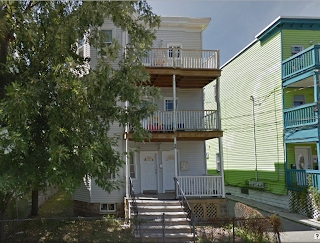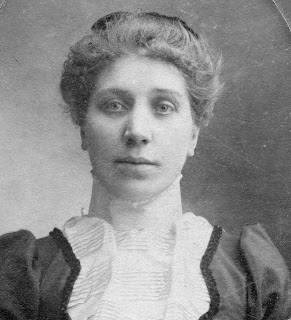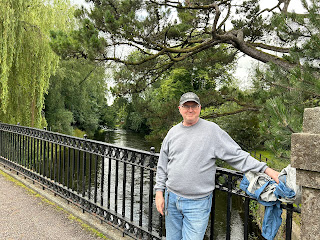This headline was too good to pass up for a Halloween post! My subject today is a follow on from the last post on the Barthelsons in New York City. As I noted then, I've been somewhat surprised at the number of people in the family that emigrated to the U.S. Not all of them stayed permanently, but since I started out knowing only about one or two, it's been quite a revelation. This line of inquiry was really instigated by a cousin's query. I'd been burrowing back through the records on Barthelsons, and as I did so I was recording what I found on ancestry.com (if you're interested, I think you can see what I've gathered: it's all under the Johnson Family tree, under the user name baeus2). Anyway, I then received an inquiry about one of the persons I'd recorded, Carl Victor Barthelson (b. 1849) that was mentioned in the last post. That query came from a direct descendant of Carl, Anne Meyer Nordström – so thanks to you, Anne!
The Carl Victor Barthelson in question was born in Västerås, Västmandland, in 1849, son of Per Barthelson and Kjerstin Persdotter. On 5 May 1872 he married Anna Christina Eriksson in Karlstad, a city in the province of Värmland (to the west of Västmanland). Together they had six children: ill-fated twins Anna Christina and Elin Maria (1872-1872), Victor Emanuel (1873?), Carl Johan (1875-?), Anna Viktoria (1877-1877) and Herman Mathias (1879-?). The question marks aren't meant to signify any great mystery, only that I haven't yet had the chance to follow up on those persons in the records. Carl Victor's profession is recorded as “slaktare,” Swedish for butcher or meat-cutter. I understand that this was the family business, and quite a number of Barthelsons have this as their profession in public documents. You may remember that when my great grandmother, Lottie, had her mother committed to the Brooklyn Home for the Aged, the document said that the mother's father was a butcher. Also that our poor lamented August Barthelson had been a well-to-do butcher in Sweden.
For reasons that are as yet unknown, in 1884 Carl Victor Barthelson left his wife and three children in Karlstad and emigrated to the U.S. As far as I know, he never returned. His wife, Anna, lived until 1922. Therein lies a tale, I'm sure. My focus in this posting, though, is was happened to Carl Victor in the States?
If you get on ancestry.com and search for that name, one of the early hits you'll find is a man named Carl Victor Barthelson, living in Kansas City, Missouri. Actually, the name varies a bit, but is still recognizable: Carl Victor, Karl Viktor, Charles V., Charles W. I won't bore you with all the permutations by which supposedly literate American recorders murdered the name Barthelson. Aside from the name itself, this gentleman is particularly attractive as a match for our Swedish emigre because he, too, was a butcher/meat cutter. I'll bet that there was a lot of work for that profession derived from the stockyards of Kansas City.
We're generally in good shape as far as the availability of records goes as well, because the state of Missouri has placed not only the data from their birth, death and marriage records online, but you can also download copies of the documents themselves! We can find, for example, a copy of the marriage license of Charles Barthelson, age 25, resident of Jackson Co., Missouri (= Kansas City) to Miss Emma Erickson, age 26, on 29 June, 1887. Charles/Karl/Carl appears in the KC city directories, beginning in 1886 and continuing uninterrupted until 1911. Barthelson is not such a common name, neither in the U.S. nor in Sweden. Combine that with the fact that Carl Victor in KC is also a butcher, the we have a match, right? Not so fast, my friend.
The glaring inconsistency – undoubtedly noted by the math fiends – is that the Carl Victor in Kansas City was claiming to be substantially younger than the Carl Victor that left Sweden. The latter was born in 1849; the former – both on the basis of his marriage license as well as the censuses of 1900 and 1910 – was born around 1862, a difference of 13 years plus or minus. Now I can understand hedging your age (Jack Benny comes to mind!), but could you really pull off saying that you're 13 years younger than you actually are? Although I might say no, it's impossible to definitively say one way or the other.
As a result of this impasse, I just didn't know what to make of the Kansas City records. But I think I may have broken through the logjam. The break came when I was trying to write an earlier blog post about my 2nd great grandmother, Catharina Charlotta Barthelson. Her father had died and mother remarried, and I was having a bit of trouble trying to track her whereabouts after her father's death. I found her, eventually, in 1861 living in Västerås along with the focal point of this post, her brother Carl Victor. But then I noticed a couple of things in that record. First, above Carl Victor's name was the annotation “Fosterbarnet herren” (I think I've got that right), indicating that the names below were the foster children of those listed above. And above that, as head of the previous family, was a name I didn't recognize: Lars Persson Bartelsson. That surname was too close to be just a coincidence, don't you think?
A couple days of digging revealed that Lars was born the illegitimate son of Catharina's father Per, hence the Persson. I'm not sure how or if he was ever legitimized – yet another trail to follow – but it is clear that he was Catharina's uncle. Not only that, but as you can see in the record, one of the sons of Lars Persson Bartelsson was named Carl Victor Bartelsson. More than that, this Carl Victor was born on 4 September, 1862, and therefore was exactly the same age as the butcher in Kansas City. As with so many others in the family, Carl's father, Lars, was a butcher. Lars died young, a victim of alcoholism and delerium tremors. I haven't seen any record of this Carl being classified as a butcher in the Swedish records, though. He emigrated at the age of 19, unmarried, and destination unspecified other than North America.
What happened to the Carl Victor of Kansas City? Carl and Emma had two children (that I know of), a daughter Hildur born in 1888, and a son Harold born in 1897. Emma was committed to a state hospital in 1906, and she remained a ward of the state until her death of a stroke in 1920. As I noted earlier, Carl Victor is in the KC directories until 1911. A helpful contributor to ancestry from that area posted a transcription of the short notice from the Kansas City when he died at the age of 50 in 1912. Daughter Hildur never married. She was a music teacher in Kansas City until her death in 1942.
Harold served in the U.S. Army in World War I, in 1919 achieving the rank of Corporal, Company H, 63rd Infantry. He eventually settled down in the Bay Area of California, where he married Helen Joyce Holloway in 1921. Joyce was a prominent pianist, and the two met during a visit she made to an army camp where Harold was stationed. The couple divorced sometime between 1928 and 1936, but she retained the use of the name Barthelson for the rest of her career, even after remarrying. Joyce's career was a great success. She studied at the Oakland Technical High School in California, graduating in 1918. She attended the University of California, Berkeley; studied piano with Elizabeth Quaile, Helene Barere and Harold Bauer, composition with Julius Gold, Otto Cesana and Roy Harris, orchestration with Nicolas Flagello, and conducting with Antonia Brico. From 1922-1935 she toured with the Arion Trio, playing with Josephine Holub (violin) and Margaret Avery (cello). In the photo, Joyce is in the center, with Josephine on the left and Margaret on the right (I think!) She was staff pianist NBC radio San Francisco and KGO Oakland, and in 1936-1938 conductor of the Women's Symphony in New York. In 1944, she and Virginia Hoff Greenburg founded the Hoff-Barthelson Music School in Scarsdale, NY. In 1942 she married Benjamin Morris Steigman, but continued to use the name Barthelson through the rest of her life. She died in Scarsdale in 1986.
To briefly go back to Harold, in 1941 or 1942 he married Ardis Sara Olive Jones, a dental hygienist. He was a builder. They continued to live in the Bay Area for many years, and later moved to Magalia, California. Harold died in 1983, and Ardis in 1993. As far as I know, neither had any children.
I've probably digressed too far. To summarize, I've pretty much concluded that the butcher of Kansas City probably isn't the Carl Victor Barthelson we'd been searching for. He's likely a relative, but not the target. I would really love to see his death certificate in the hope that his parents' names are listed. He died in a hospital in Kansas City, Kansas, but the state has no documentation for him. They suggested that I check in Kansas City, Missouri where he lived. But the death certificate isn't in their on-line records. I suppose there's a chance that they have the document but, for some reason, it wasn't digitized and placed online. So I'm pretty much back at square one. There is still the unidentified brother of Johan August who was living on West Twenty-sixth Street in Manhattan to find, and that seems like the best bet for progress.
One thing that I've learned from this exercise is that coincidences occur more commonly that I'd thought. We started out looking for a butcher from Sweden named Carl Victor Barthelson. Well, we found one, but it turns out that he wasn't the right one. And I learned that he's not the only one: there was another Carl Victor Barthelson, butcher, who moved from Sweden to Chicago (and later to New York). I'm pretty sure that this isn't the one I'm after, either, since he had a child born in 1882, the same year that the Swedish records say that my Carl left Karlstad for the U.S. The lesson is to get as much corroborative evidence as possible, but still always leave open the possibility that your conclusions will turn out to be wrong!























.jpg)






















